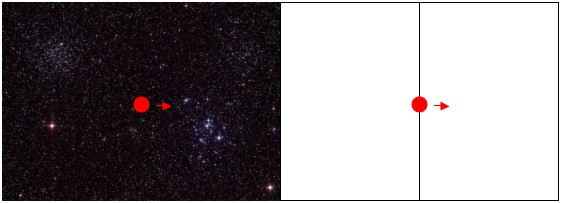Physicist: Hells yeah.
Fastest fast: This is worth commenting on since you often hear “nothing can travel faster then light”, but the justification is almost always missing. The universe seems to be pretty happy thinking of the speed of light as being the same to everybody first (Maxwell’s Laws give you the speed of light, but Maxwell’s laws are the same to everybody so the speed of light is the same to everybody), and as a speed limit second. Since you always see light moving at the same speed, then no matter how much you speed up, it will always pass you by. So catching up to it isn’t an option, and everyone will always see you traveling slower than the speed of light.
Densest dense: The harder you compress something, the denser it becomes. Normally this is reflected in the distance between atoms shrinking. However, if the pressure is great enough, the atoms will find that it’s easier to have their electrons merge with their protons which then turn into neutrons (and also spit out neutrinos, but whatever). Without battling electron shells, the once mostly-empty atoms can be packed nucleus-to-nucleus. Pressures and densities this high only seem to show up in neutron stars (guess where the name comes from). By way of comparison, here are some densities (in kilograms per liter): Air = 0.0012, People = 1, the Sun = 1.4, Iron = 7.8, Gold = 19.3, Neutron Star = 500,000,000,000,000.
You can also cheat a little. If a neutron star has a mass of more than about 5 Suns it will collapse into a blackhole, which is technically more dense.
Coldest cold: You might have guessed: zero. Specifically 0°K = -273°C = -460°F. However, this is more of an “asymptotic limit” and can never quite be reached. An object with a temperature of absolute zero will have no atomic movement (heat) whatsoever, but that’s not possible. One way of thinking about it is in terms of the Heisenberg uncertainty principle which, in a paraphrased nutshell, states: “You can’t have both a perfectly certain position and a perfectly certain momentum”. Where and
are the position and momentum errors respectively, the uncertainty principle can be written:
.
So if you’ve got a substance and you have any idea where it is (), then you can’t be sure that the momentum is zero, and the object will always have at least a little atomic movement. Most people who have heard of Heisenberg’s uncertainty principle are under the impression that it’s a limit on how well we can know about an object. In fact, it’s far better to think of it as a description of how well the universe can know about an object.
Despite the difficulties imposed by the uncertainty principle, we can still get things crazy cold. The world record for lowest temperature now stands at 0.0000000001°K = 0.1 nK.
Hottest hot: There are actually two limits here, depending on how you phrase the question. The first is the theoretical upper limit, which depends on which theory you’re working with, but is often quoted around 1030 °K. These limits have to do with “the graininess” of space, and how much energy can be forced into a particular region.
The second kind of limit is more practical. As a gas is heated its atoms move faster and faster. When they collide they bounce off of each other and often create photons (light), which generally just go on to push other atoms around. However, as the temperature approaches about 4 billion °C, the atoms of the gas will often have enough energy to create electron/positron pairs (“E=mc2“, where “E” is the kinetic energy of the gas atoms, and “m” is the total mass of the electron/positron pair). Normally these newly created particles will almost immediately find other electrons and positrons and annihilate, creating light. But sometimes they’ll create neutrinos instead of light. Neutrinos are “weakly interacting” (which is science speak for “goes through walls, no problem”), so the energy used to create them just flies into space, never to be seen again (or just about never). This has the effect that a gas with a temperature above around 4,000,000,000°C will cool off on its own (without seeming to radiate any energy). For comparison, the core temperature of the Sun is about 15.7 million °C.

The Sudbury neutrino detector: 40 feet across, and among the more evil looking things ever built. Image stolen without remorse from "http://zuserver2.star.ucl.ac.uk/~idh/apod/ap990623.html"
This is sometimes important during stellar collapse. If a star needs to have a core temperature above the cut-off point to hold itself up, then it’s not going to hold itself up.
Smallest small: Again, for “uncertainty principle type reasons” it doesn’t make sense to talk about objects or events smaller than the Planck scale, which is about 10-35m. So far, nobody can think of anything in the universe, at any scale, that would really care, or be able to tell the difference between two points separated by 10-35m.
Emptiest empty: One version of the Heisenberg uncertainty principle can be written ““, which means that the time and energy of something can’t both be perfectly well known (not even by the universe, the quantities themselves are uncertain). If you apply this principle to empty space you’ll notice that over short enough time scales there will be measurable, non-zero energy, and over really short time scales you’ll find particles popping in and out of existence. These particles are called “virtual particles”, and this phenomena is sometimes described as a “particle foam”.
So even with a perfect vacuum, you’ll still have crap around. This crap is often called the “vacuum energy” or “zero point energy”.

One of the few examples of a device that can harness the vacuum energy of the universe to charge your chrystals or whatever. This illustration of "pyramid power" stolen from "http://www.merlinsrealm.com/pyramid-power.htm"
Sadly, harvesting the vacuum energy is physically impossible (it would violate the uncertainty principle). The vacuum energy amounts to about 10-13J/m3, or about “the energy a baseball has falling off a table per volume of Lake Superior“.

![The Woolly Mammoth, or "Mammuthus primigenius", roamed most of North America and Eurasia during the last ice age. The pattern of their extinction seems to have exactly paralleled the advance of Homo sapiens sapiens across those regions, although representatives of the Bush administration have noted that, since "science" claims that the "events" happened before 4000 BC, they must not have happened at all. Said Scott McClellan, "Science is whatever the [ultra rich] believe it should be".](https://www.askamathematician.com/wp-content/uploads/2010/03/WoolyMammoth.jpg)







